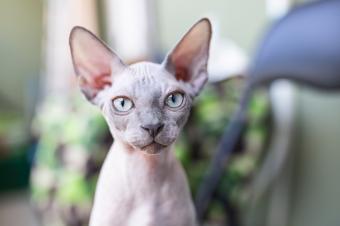
Himalayan cat colors range from lilac to chocolate lynx and dozens of other shades. And fun fact: lilac point and chocolate point Himalayans have almost the same genetic makeup, though they look drastically different. Understanding the amazing variety of colors found in Himalayan cats can help you appreciate this beautiful breed even more.
About Himalayan Cat Colors
Thanks to the hard work of several breeders in preserving and extending certain color traits, a variety of Himalayan colorpoint shades are now recognized by the Cat Fancier's Association (CFA). This is definitely an accomplishment because the CFA is a longstanding cat association that represents the most conservative standards within the breeding world.
Himalayan Colorpoints

Himalayan cats are a colorpoint breed that is typically categorized within the Persian cat division. The term colorpoint translates to a cat with an even and light-colored body, but their face and extremities feature a darker coat color.
These cats have a darker "mask-like" shade across their faces, along with darker fur along the length of the tail and the tip of the paws. The body of a Himalayan colorpoint is typically ivory or fawn.
Show Himalayans must have an even color across their body to emphasize the contrast of their paws, tail, and face. Points are docked for any markings, and, in fact, markings can render a cat ineligible in many cases.
Himalayan Cat Color Varieties
Although the CFA is generally extremely conservative regarding acceptable color shades for many breeds, they're generous with the Himalayan division because not all Himalayan colors were recognized from the start. Currently, a variety of color point combinations are acceptable. These include:
- Chocolate
- Seal
- Lilac
- Blue
- Red
- Cream tortie
- Blue-cream
- Chocolate-tortie
- Lilac-cream
- Seal lynx
- Blue lynx
- Red lynx
- Cream lynx
- Tortie lynx
- Blue-cream lynx
- Chocolate lynx
- Lilac lynx
- Chocolate-tortie lynx
- Lilac-cream lynx
There have been breed favorites over the decades, and colors such as lynx points only received recognition in the late 70s and early 80s.
Colorpoints and Genetics
Some of these color combinations are rare and difficult to breed for consistenly. Himalayans that feature chocolate and lilac points are among the more unique of colorpoints since the genetics involved in such breeding are complicated.
Chocolate Point Himalayan Genetics

Chocolate is a very recessive gene, and it is necessary for both sire and dame to carry this allele in order for any kittens within a litter to bear the chocolate color. Cats with this coloration have rich, brown points on their face, ears, paws, and tail.
Lilac Point Himalayan Coloring
Lilac point Himalayans are the diluted version of the chocolate point. They have the same genetic makeup with two copies of the chocolate gene, although lilacs also carry the dilution gene. As a result, these stunning cats have purplish-gray points with a light gray body.
Himalayan Tortie Point Cats

Himalayan torties have an ivory body offset well by tortie points. In fact, these color combinations are, according to the CFA, reportedly the "darlings of the Himalayan world." Breeders who enjoy sleek and striking colors generally avoid tortie patterns because they can be chaotic. However, for the Himalayan cat, the tortie colors are apparently an asset.
If you are unfamiliar with the term "tortie" in reference to a cat color, the term is the shortened version of "tortoiseshell," which describes the pattern of this shading. Torties have a mottled hue of certain colors similar to those of a tortoise's shell. This color can be both complicated and interesting, and it adds a certain flair to a colorpoint.
Himalayan Cat Seal Points

Seal point Himalayans have points on their ears, facial mask, legs, paws, and tail that are a rich brown color, which is known as "seal." Their paw and nose pads should also be the same brown color. Like other Himalayans, the rest of their body is white to a pale fawn color. Seal point Himalayans were one of the four original colors accepted by the CFA in 1957.
Himalayan Cat Lynx Points

Lynx points are amongst the last to receive recognition, and this color combination is even more striking than the tortie. A lynx pattern is stripey and tabby-esque. It can present a very interesting contrast against the single-shade body of a Himalayan.
Science Behind Himalayan Cat Colors
If you're purchasing a Himalayan cat for show or breeding purposes, it's very important to analyze your cat's pedigree for information regarding recessive and dominant genes in the field of color. But if you're just curious about why your Himalayan or Himalayan-mix cat looks the way they do, now you know!







